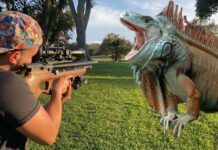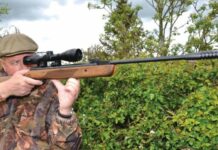
Having survived prowling predators, the whitetail fawn now matures.
Spring gives way to warm days as the summer season nears. Pesky insects start to dominate the woodlots and open fields. For the young whitetails that survived the pursuit of predators, now their lives of growing into mature deer begin to unfold.
If the parenting female doesn’t reject her offspring, which is usually due to nutritional stress, a hormonal imbalance, inexperienced first-time mothers or disease, then the process of maternal guidance is under way.
The deer fawn, although it possesses certain inborn survival instincts, still takes its lead from its mother. Foremost are concealed bedding sites, which are pre-chosen by the mother. If these locales remain undisturbed, she will use them year after year — especially if she has raised young before.
These bedding sites are essential for the fawn to conserve energy and digest nutrients for growth. The fawn is growing rapidly by now, but it still spends the majority of time bedding.
By its mother’s vocal commands and through scent-bonding, the fawn learns where these sites are within days after birth. Bedding locales, through the mother’s lead, are reinforced. The fawn can also go to bed on its own or by her cue as it matures. Besides nutrition, this aspect of the fawn’s development is crucial as to whether the infant survives and properly matures.
The mother also guides the newborn to specific feeding areas, and of course, the fawn quickly learns where the nutrients are. Besides periodically nursing from its mother, the deer fawn within just a few weeks after birth is able to forage on its own. Yet it’s still dependent on the protein content of its mother’s milk.
Deer researchers have determined that the nourishing milk of whitetails is high not only in protein but fat and vitamins as well. It also possesses colostrum, which is basically an antibiotic to resist disease.
These bedding sites and feeding locales are continually imprinted through the mother’s scent and visual guidance. Along with its inborn instincts for survival, the newborn learns to adapt and survive.
At times, the fawn is highly frisky — darting to and fro from its mother and other deer. Here, the young deer sharpens its skill to evade predators. Also, playful behavior is associated with the social order of deer as well. These behaviors and responses from the herd can determine the fawn’s status within the herd even at a young age. However, this socialization is usually more intense with female fawns than young bucks, which will eventually disperse on their own.
If nutrition and fertility are on course, females can easily give birth to twin fawns. The two youngsters are usually close together, and tend to watch out for one another. Overall, if the doe isn’t a first-time mother, her offspring from previous years will also put their eyes and ears to work — staying keen to predators. Although there are exceptions, this is typically the trend once the fawns are mature enough and accepted into the fold of older deer.
Although a button buck usually stays with its mother during its first year, there are rare situations when the young male unites with a bachelor group of bucks. Otherwise, the button buck stays with the female clan — eventually going out on its own the following year. Also, button bucks can be forced away temporarily by both dominant males and breeding females when procreation calls during the rutting season.
Gradually, the parenting female begins to shun the buck fawn — sometimes kicking and swatting at it when it attempts to nurse. She may even actually kick and charge the young male. Although the infant may stay within her range through the winter, she usually doesn’t show it any maternal attention by then.
A normal buck fawn can be rejected by its mother, yet it can also be naturally inclined to disperse on its own as well. The instinct to procreate drives it to seek out mates. In time, he leaves the doe herd on his own — even if the mother doesn’t drive him off.
Whether the button buck is on its own or within the close-knit clan of its mother and her offspring, it can easily be mistaken for a female deer — especially if antlerless harvest is on the agenda. Here, proper identification of a young male deer is crucial when certain laws are implemented for taking whitetails or if one is practicing QDM. Although it’s currently legal to take a young button buck without a polished antler above the hairline, most hunters want to pass on young males — giving them the opportunity to grow and mature. Simply, button bucks are considered to be an antlerless harvest. However, always check the current regulations to be sure the law hasn’t changed.
A button buck usually stands out from females. Of course, by the end of the summer, most female and male deer fawns have lost their spots. Body formations are a way to distinguish male from female. Young male deer have shorter necks and are somewhat squared in comparison to long-necked does. Usually the female is longer than the button buck. He also tends to wander from the females from time to time, and forages on his own.
Basically the fastest way to determine a button buck is to look for small growth on its forehead where the pedicels are located between its ears. Usually by the fall, some button bucks actually have small, undeveloped antlers protruding up, but are covered by hair. Depending on nutrition and genetics, some button bucks may even sprout a small set of spikes, but this is extremely rare.
The following year is when antler growth becomes more noticeable as the button buck grows and matures into a 1½-year-old antlered deer.
Female fawns usually stay with the doe clan for a couple of years or until they become first-time mothers.
For whitetails to reach maturity and maintain procreation, nutrition and the quality thereof is extremely important. That’s next month’s topic.











































